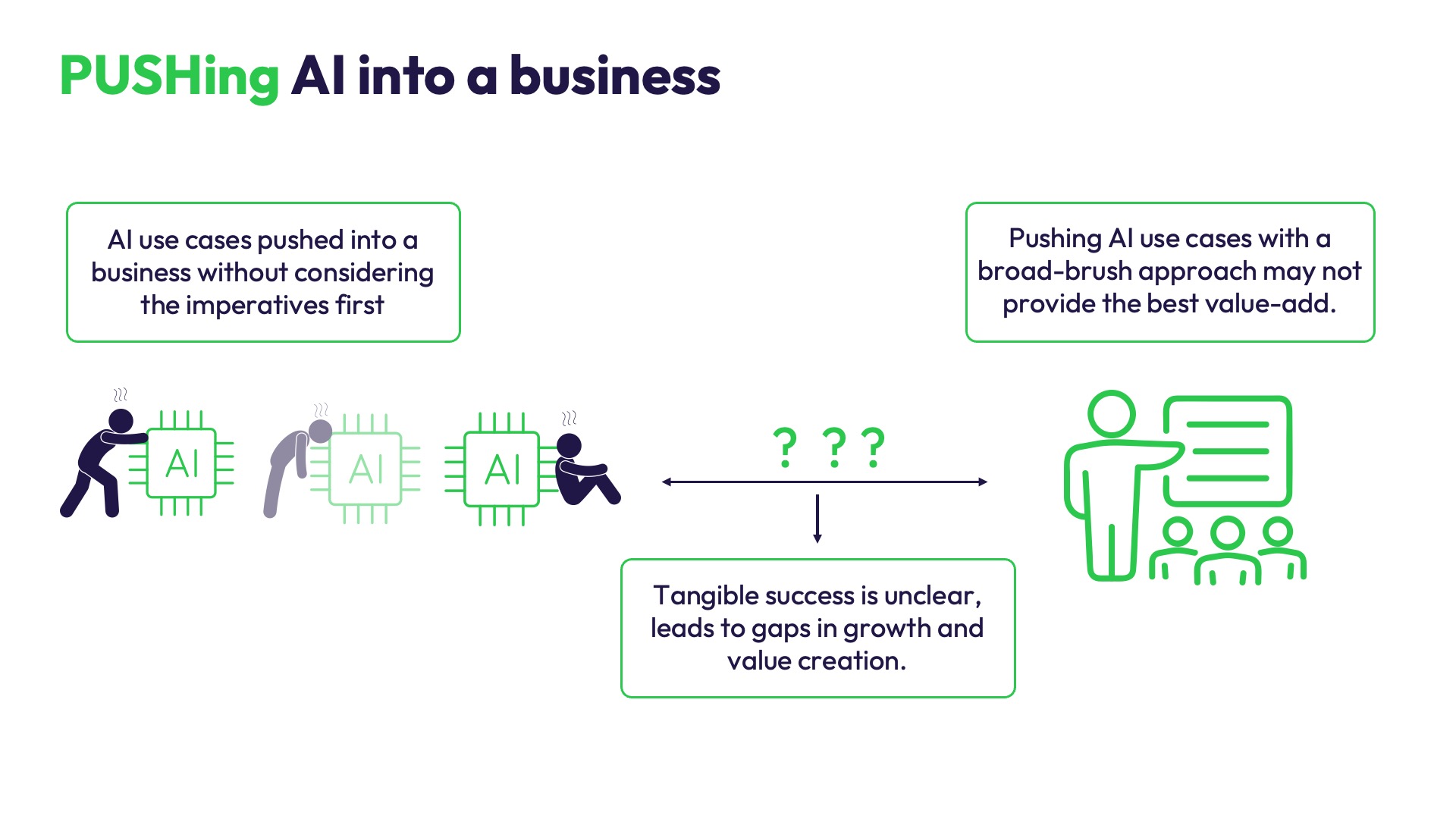



Point of View | Technology | Data & AI

Engage in a strategic dialog that empowers enterprises to build with AI by pivoting from a ‘use case’ mindset to a ‘business imperative’ mindset.
In the last decade, digital technologies have integrated into businesses, enriching customer experiences and streamlining operations. The next ten years will see AI-infused transformation take the mantle to drive more powerful insights and bolster innovation, creating faster, more adaptive systems that help people. Over the past 18 months, OpenAI’s ChatGPT captivated global public interest, marking a watershed moment for Generative AI in mainstream technology discourse. Since then, industries and businesses have focused on uncovering various use cases around AI implementation. The prevailing narrative during this time has centered around two pertinent questions, “Where do we apply GenAI?” and “How many business use cases can we address with AI?” There is no doubt that AI has created much excitement. This anticipation led many to swiftly match industry problems with AI, and the endeavor after that was to figure out how AI or GenAI could be applied to solve these problems successfully.
Today, there are numerous problems that organizations wish to solve with AI. The reality, however, is slightly different from the prevailing narrative. The incentive to put another AI use case in the pipeline remains elusive. Enterprises spend much capital on building use cases. But the value-add from when an AI use case is ideated to deploying it in a production environment that solves business challenges at scale remains challenging. It can lead to growth and value creation from the AI to decline. Implementing a broad-brush approach may not be the most effective way for enterprises to enhance their pipeline in the long run.
Business challenges come in many shapes and sizes and might not align with an AI use case from the get-go. Instead of immediately seeking AI, focus on the core challenges and identify the ‘sweet spot’ to integrate AI effectively. This approach emphasizes addressing the most pressing business issues first and then leveraging AI to add value. It is essential to recognize that the nature of a business problem often varies depending on a user cohort. For example, a CEO’s problem statement may differ significantly from that of a functional leader within a specific department. Therefore, it is crucial to nurture a dialog addressing the most critical business imperatives at an enterprise level within a realistic timeframe of six to 12 months.
Take application support, for instance. Organizations often run on multiple applications that need to work seamlessly with minimal latency and maximum responsiveness for a robust user experience. Look at this function and determine if leveraging AI can truly create incremental growth in addition to streamlining processes. Conversely, think about holistically reimagining the entire application support process with AI. This will naturally lead to organizations having multiple streams around technology, data, change management, upskilling, and governance (since we must account for all the bases impacted when we reimagine a business function with AI).
This is what clients yearn for—a future state where automation drives at least 80% of tasks that previously required human oversight but with a high degree of contextualization curated to the business function’s ask. By narrowing down the specifics of a problem, we can identify opportunities to address imperatives with AI. Simply ideating multiple AI pilots or proofs of concept may not be sufficient. It is paramount always to consider the larger human context for AI use cases to yield long-term tangible value.
To capture business value, leaders must transform core parts of their business or a particular business function with AI. For example, AI-powered automation streamlines tasks, predictive analytics provides accurate forecasts, and AI-driven chatbots improve customer service. These benefits enable organizations to achieve more in less time, reduce errors, and make swift, data-driven decisions, driving growth and innovation. There is much excitement surrounding AI. While the enthusiasm encourages businesses to explore AI’s potential, it is essential to take a step back and consider whether we have the necessary AI-ready data, skills, technology stacks, change management processes, and governance as enablers to maximize its potential.
The pressing question(s) to ask are: how do we find a tangible value proposition that will pivot our business to the next level? Is AI the only response to an imperative, and if so, is the AI mature enough to solve challenges for that imperative today? Above all, how do we envision an AI value dashboard that quantifies the path from ‘measurement’ to ‘optimization’? Once we answer these questions, we can adjust our strategy to set a trajectory that meets set goals. Also, acknowledging that AI might be one of many answers is crucial. Additionally, ask if we are burning too much capital to build technology around our AI use cases. Will AI implementation disrupt employees? Have we really gained significant economic value by restructuring teams or replacing talented people with AI use cases that may evolve?
Pivot to value with AI is this: we redesign business with AI. The fundamental beacons of a successful business are robust customer acquisitions, superior product innovation, and enhanced organizational efficiencies. The ‘pivot’ revolves around visualizing current business imperatives and how AI can be pulled into it. In other words, it’s a pull rather than push approach. Instead of pushing AI into our operations, we rethink how we can enable the business to pull in AI solutions driven by specific imperatives. Determine an AI roadmap that enables the imperative and as part of that roadmap, figure out use cases such as process changes, governance, technology, and data to be assembled.


Focus on imperatives that reimagine a function, considering AI’s capabilities that can be introduced into the mix for that function. Pivot to value is an enterprise AI strategy. It steers clear of a one-size-fits-all approach. Lastly, human endeavor and oversight play a crucial role in AI’s adoption. Regardless of the level of AI being deployed for a business, the ‘human’ context always puts the business imperatives into perspective.